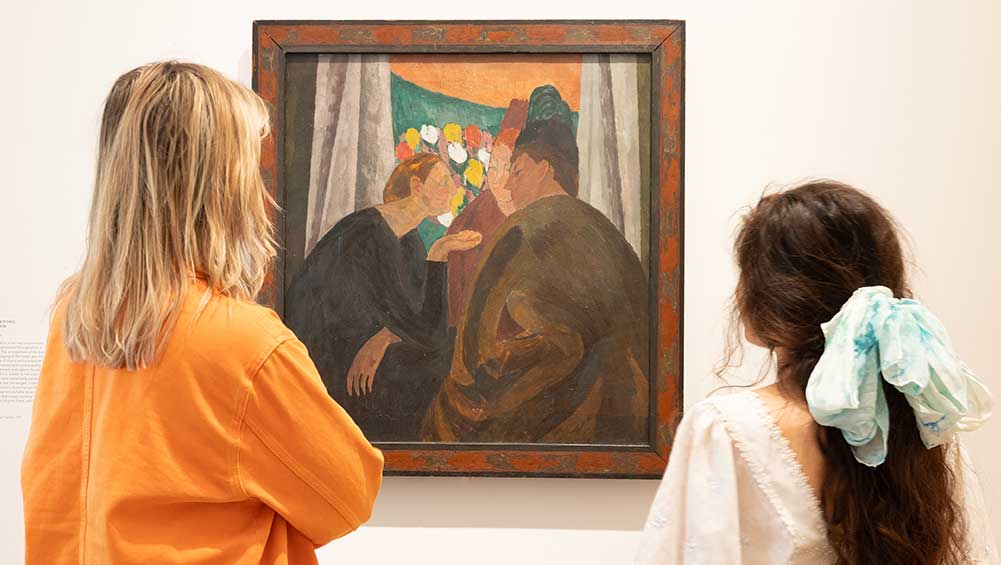
Installation view, Vanessa Bell A Pioneer in Modern Art, The Courtauld Gallery, 2024. Photo: Fergus Carmichael/The Courtauld.
The Courtauld Gallery, London
25 May – 6 October 2024
by NICOLA HOMER
A trio of women deep in conversation sit next to a window through which a garden is visible. A Conversation (1913-16) by Vanessa Bell features in this latest exhibition at the Courtauld Gallery, composed of a finely curated selection of paintings. Bell (1879-–1961), who trained at the Royal Academy Schools, conveyed a feminine vision as she moved in avant-garde circles of Europe. This exhibition focuses principally on the 1910s, a time when the artist was experimenting with colour and form. Drawn from the Courtauld’s holdings of Bell’s work, the display is organised into two rooms, beginning with a gallery of paintings and ending with a room featuring designs with the Omega Workshops.
Along with her sister, the novelist Virginia Woolf, Bell was a founder of the Bloomsbury set, a group of artists, writers and intellectuals that came into being in the winter of 1906-07. Yet the artists and writers of the Bloomsbury set departed from Victorian traditions as they developed a literary and artistic modernism, anticipating Woolf’s novel To the Lighthouse, drawing on her childhood summers in Cornwall. Bell shared a passion for literature with her father, Sir Leslie Stephen, a great man of letters: towards the end of his life, he read the works of a pioneer of fiction, Jane Austen, to whom Bell turned throughout her lifetime. Just as Austen displayed wit and observational skills in writing about society, Bell suggested a touch of fun and subtle powers of observation in her portrayal of the three women in A Conversation.
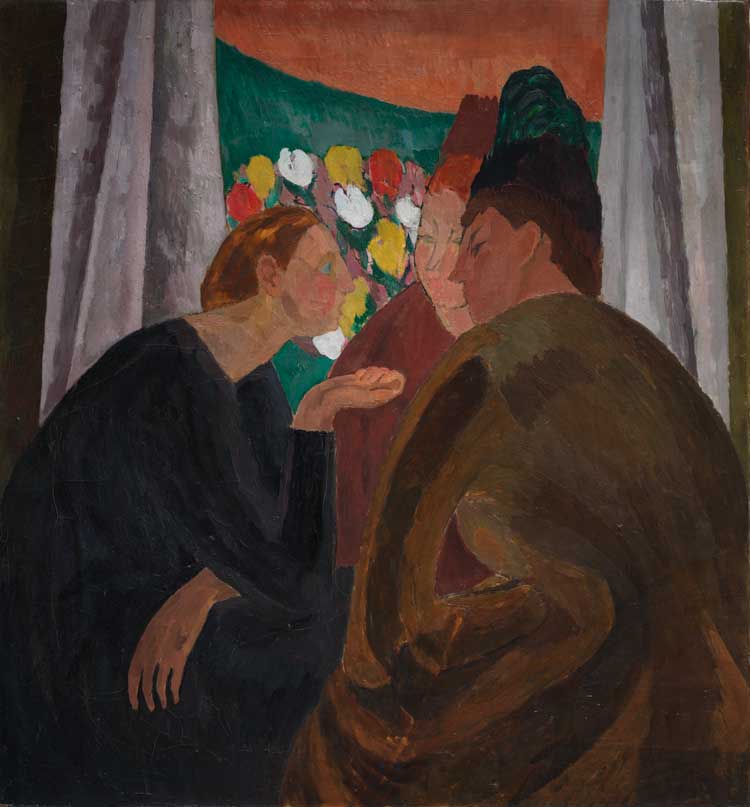
Vanessa Bell, A Conversation, 1913–16. Oil on canvas. The Courtauld, London (Samuel Courtauld Trust). © Estate
of Vanessa Bell. All rights reserved, DACS 2024.
In the gallery, the wall text next to A Conversation singles out a “humorous and incisive quality”, which garnered admiration from Bell’s sister. “I think you are a most remarkable painter. But I maintain you are into the bargain, a satirist, a conveyor of impressions about human life: a short story writer of great wit and able to bring off a situation in a way that rouses my envy,” wrote Woolf in a letter praising the painting. For her part, Bell drew a comparison between a scene with a ponderous woman from Woolf’s short story Kew Gardens and her painting of a trio conversing in front of a window overlooking a flowerbed, from which she derived inspiration for a woodcut for the frontispiece of a publication of the story in 1919. Kew Gardens is representative of Woolf’s feminist aesthetics, which went on to blossom in her masterpiece To the Lighthouse, to articulate the significance of the ordinary experience of modern women. The story featured in Monday or Tuesday (1921), the only collection of Woolf’s short stories that appeared during her lifetime, featuring the innovative short fictions The Mark on the Wall and Blue & Green.
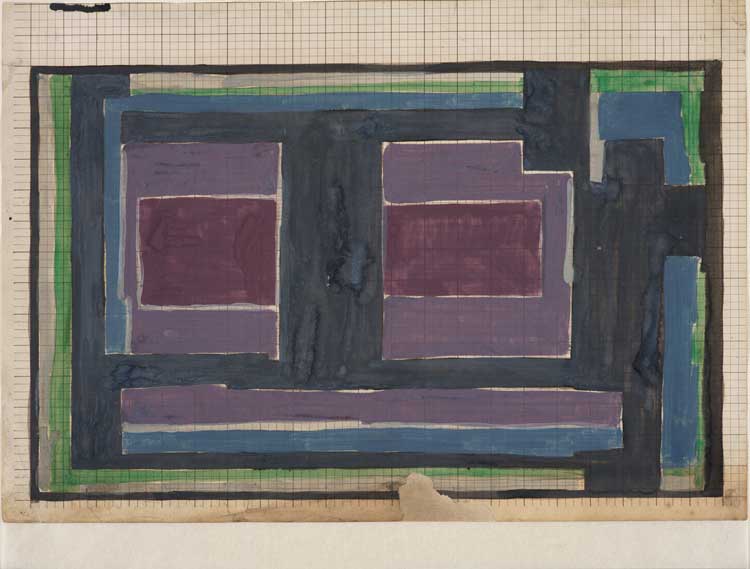
Vanessa Bell, Rug design, 1913–15. Graphite and bodycolour over a grid of pen and black ink lines, on wove paper, with a pinhole at each corner; loss of lower centre edge made up, The Courtauld, London (Samuel Courtauld Trust) © Estate of Vanessa Bell. All rights reserved, DACS 2024. © Estate of Duncan Grant. All rights reserved, DACS 2024.
The curator Rachel Sloan, associate curator of works on paper at the Courtauld, tells me: “Bell and Woolf enjoyed a long and rich creative relationship, supporting and inspiring each other whilst occasionally expressing mostly good-natured frustration at not being able to accomplish in one artform (writing or painting) what the other could. They collaborated on projects and supported each other – Bell designed numerous jackets for Woolf’s books, and Woolf reviewed Bell’s exhibitions. Woolf’s letter praising A Conversation certainly recognises that she and Bell were pursuing a shared goal: of drawing out the extraordinary and the beautiful from what might seem common and everyday (something central to the Bloomsbury group’s vision of modernism). And looking at Bell’s still lifes (two of which feature in the show) seems to have inspired Woolf to write one of her most experimental short stories, Blue & Green (1921), which can be seen as an attempt to create in words what Bell had done in paint.”
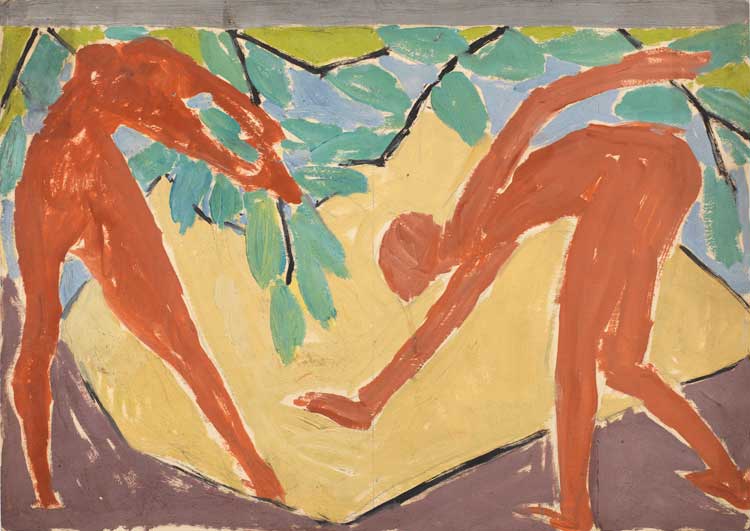
Vanessa Bell, Design for a folding screen - Adam and Eve, 1913–14. Graphite, bodycolour and oil paint on wove paper, The Courtauld, London (Samuel Courtauld Trust). © Estate of Vanessa Bell. All rights reserved, DACS 2024.
In the exhibition, you can see Bell’s still lifes in juxtaposition in the gallery leading on to a room of abstract designs for furniture and textiles, drawing on the practice of the Omega Workshops, an experimental design collective based in Bloomsbury, London, opened by the critic Roger Fry in July 1913. With the artists Bell and Duncan Grant as co-directors, Fry offered young artists the opportunity to earn some money while absorbing the influence of post-impressionism on decoration. The workshops produced interior decorations and book designs. Vanessa’s husband, Clive Bell, drew on many of Fry’s ideas in his book Art (1914) and innovated the theory of “significant form”.
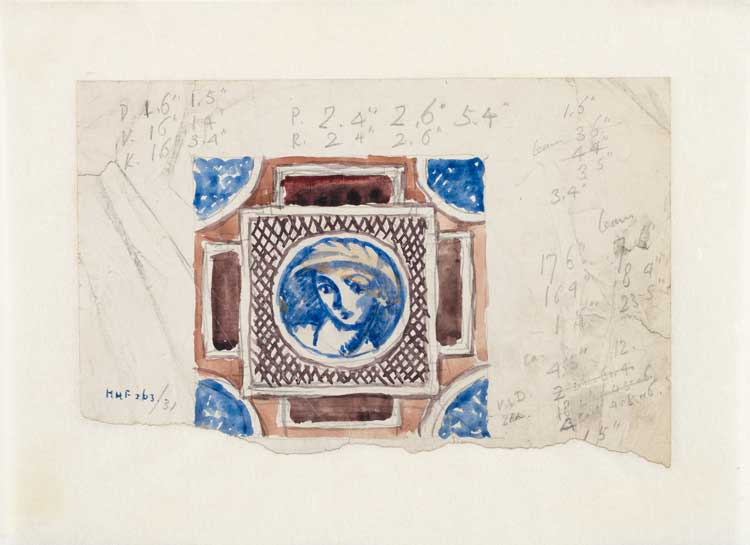
Vanessa Bell, Tile design, c1921. Graphite, watercolour and bodycolour on laid paper, now laid down on Japanese tissue; lower edge unevenly torn. The Courtauld, London
(Samuel Courtauld Trust) © Estate of Vanessa Bell. All rights reserved, DACS 2024. © Estate of Duncan Grant. All rights reserved, DACS 2024.
Fry played an important role in the British art world as he introduced the modern art of Cézanne, Matisse, Picasso and Van Gogh to an Edwardian audience with his exhibition Manet and the Post-Impressionists at the Grafton Galleries in London, which opened in November 1910. Bell conveyed a sense of excitement about the exhibition as she wrote that the autumn of 1910 “[was] to me a time when everything seemed springing to new life”. Around the same time, changes were occurring in British society, including the accession of George V and the first wave of the feminist movement, as seen in the suffragette rally at Westminster in November 1910, although it was another eight years before most women over the age of 30 secured the right to vote in the UK. As the art historian Frances Spalding wrote: “Vitality and absolute commitment motivated both the suffragettes and post-impressionism.”
In Britain, the aesthetics of Fry and the poetry of TS Eliot were characterised by a generalised religiosity that coincided with European cultural changes, seen in the publication of Freud’s The Interpretation of Dreams. Vanessa Bell moved in avant-garde circles in the liberal era before the first world war. In January 1914, she visited Paris with Fry, Clive Bell and Molly MacCarthy, who coined the term “Bloomsberries” for the group – which included the novelists Woolf and EM Forster, the critics Fry and Bell, the biographer Lytton Strachey, the literary journalist Desmond MacCarthy and the economist and philosopher John Maynard Keynes. On this visit to Paris, the poet Gertrude Stein introduced Bell to Picasso in his studio, featuring cubist artworks and portraits from his blue period.
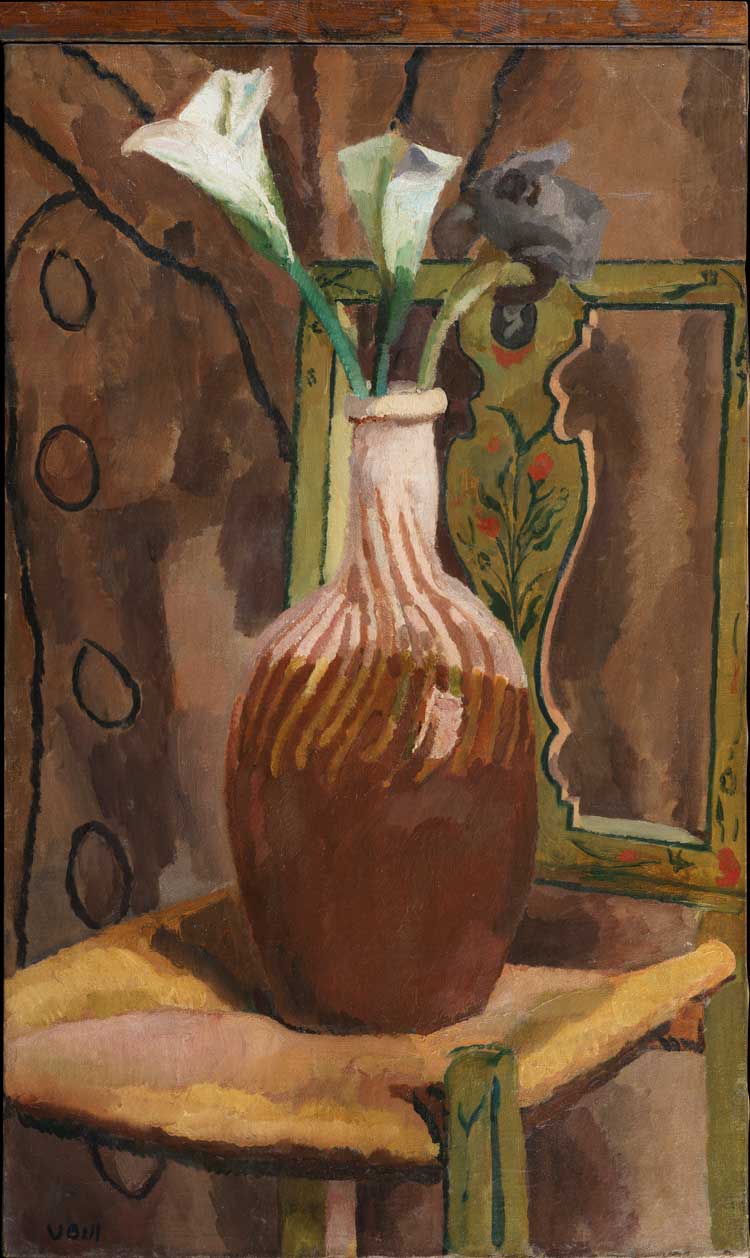
Vanessa Bell, Lilies and Iris, c1919. Oil on canvas. The Courtauld, London
(Samuel Courtauld Trust) © Estate of Vanessa Bell. All rights reserved, DACS
2024.
Bell had a long-held interest in French culture. In the summer of 1905, she started the Friday Club, with the hope of creating a cultural milieu like that she had observed in Parisian cafes, according to Spalding. With a spirit of diplomacy, she brought together avant-garde artists, drawing on friends from the Royal Academy Schools. At the exhibition, you can see a sombre view from her studio in Paris, where she worked in the 1920s, in Still Life at a Window (1922), in an elegant juxtaposition with Arum Lilies and Iris (c1919), in which a vase is placed on the type of chair found at the Bloomsbury group’s rural retreat of Charleston in Sussex. In picturing the artist’s studio and modernist home, the work calls to mind Woolf’s feminist polemic A Room of One’s Own (1929), exploring the status of female writers, famously Austen, where Woolf notes that in 1919 a woman was given a vote. The novelist’s opinion holds true for painting, as for writing, where there is an art of fiction. For the important modernist author writes: “A woman must have money and a room of her own if she is to write fiction.”
Sloan says of the curatorial vision behind this exhibition: “The Courtauld holds an important collection of Vanessa Bell’s work, as part of a broader collection of the work of artists associated with the Bloomsbury group and the Omega Workshops. Up until now, Bell’s work had always been exhibited here alongside that of her contemporaries. The time seemed more than ripe to devote a monographic show to her – amazingly, only the second (after the Dulwich Picture Gallery’s 2017 exhibition) – that showcases her work and that allows us to view and appreciate her as an artist in her own right, and a pioneering figure of modernism in Britain.”
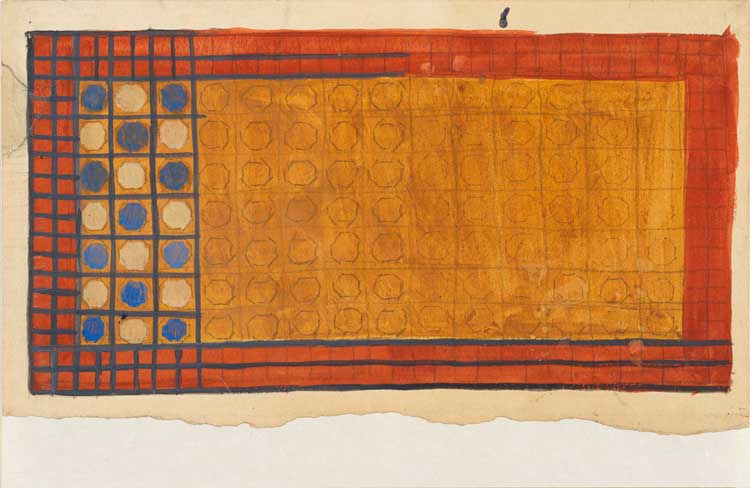
Vanessa Bell, Rug design, 1913–19. Graphite and bodycolour on wove paper, with pinholes at upper left and lower right corners, The Courtauld, London (Samuel Courtauld Trust). © Estate of Vanessa Bell. All rights reserved, DACS 2024.
Sloan addresses how the exhibition is curated and why people should visit the show this summer: “Because the display is drawn entirely from the permanent collection, its shape was necessarily dictated by the nature of the works available; this means that the primary focus is on Bell’s most radical and experimental period, the 1910s. I also wanted to showcase the whole range of her creative output, so the display includes paintings, a print, and a representative selection of her designs for the Omega Workshops – several of which can be considered among the first works of pure abstraction in British art, and all of which speak to her interest in dissolving the distinction between the so-called ‘fine’ and ‘decorative’ arts. The show should offer visitors a good introduction to the work of an extraordinary artist who has been too long overshadowed, and who is only now beginning to be appreciated as the innovator she was.”
She adds: “The Courtauld Gallery has an outstanding collection of work by Bloomsbury artists, which has been the subject of a major exhibition in 2010 and which now has a permanent showcase in a gallery devoted to these artists on our top floor, making a show devoted to Vanessa Bell a natural choice. In recent years we have been making a concerted effort to showcase the work of women artists here, both in our collecting and our exhibition programme, and following our 2022 exhibition on the vorticist artist Helen Saunders, focusing on Bell seemed a logical next step. (It’s worth noting that both artists moved in similar circles, and Saunders was briefly a member of the Friday Club of avant-garde artists, founded by Bell, although their work soon went in very different directions.)”